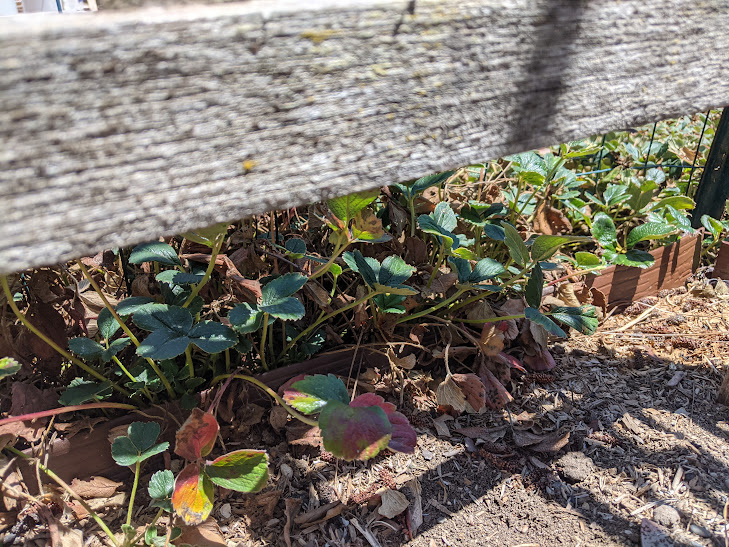Beach Strawberry Evangelism

I have beach strawberry as my primary ground cover instead of grass and ❤️ I LOVE IT ❤️
If you are already a fan, you can jump directly to the section on rooting.
Pros & Cons
Pros:
- Native to CA
- Drought-tolerant
- Never needs mowing
- Suppresses weeds
- Spreads by itself
- Stands up to some traffic
- Doesn't seem to suffer from any diseases or pests
- Unappealing to gophers (in my experience)
- Flowers relatively early in spring to feed the bees
- Stays green year-round
Cons:
- It can crowd out small plants
- It's hard to keep confined
- It's harder to rake
- It is not as soft as grass on the feet.
- The runners might trip small children. (I have no actual experience of this.)
More on the pros/cons:
Pro #4: Suppresses weeds
Here is a partial list of weeds I had in the past (and still have where there isn't strawberry) but don't have (or only find occasionally) in the strawberry:
- Oxalis (!!!)
- Bermuda grass
- Bindweed
- Dandelion
Pro #5: Spreads by itself
I started with nothing but bare dirt in my backyard, and being the lazy-but-patient type of gardener, I put out a few clippings of strawberry, about 3-4' apart (yes, that's FEET), watered regularly until they were rooted, and then let spread by themselves. Occasionally, I'd reposition runners so that they'd spread more evenly and fill in gaps. After about 2 years, most of the yard was full, and there were just a couple of spots where it was a bit sparse, I think because the sprinkler didn't really cover it well.
Pro #6: Stands up to some traffic
My dogs have worn a path between the doggy door and the spot on the fence where the squirrels sit, but that would've also happened to grass. The good news is that [see Pro #5] the strawberry will send out new runners, so (if the dogs ever stop chasing the squirrels) it will grow back, whereas grass wouldn't grow back on its own.
Con #1: It can crowd out small plants
Since it spreads by runners, the runners will grow over low-lying plants. No creeping thyme. Even my cranesbill are struggling to hold their own against the strawberry. You can't just toss out seeds and expect anything to break through. Of course, this is exactly why it does such a good job of suppressing weeds [Pro #4]. To add anything to an established strawberry bed, you need to cut a hole in the strawberry, plant your new plant, and keep the strawberry runners away until your new plant is big enough to stand up to the strawberry. Bigger perennials and bulbs/rhizomes do fine. Some of the plants I have growing in the middle of the strawberry are: different types of irises, belladonna lilies, fuchsia, agapanthus, crocosmia, lavender, Mexican sage, and dusty miller.
Con #2: It's hard to keep it confined
This is the flip side of Pro #5: spreading. Strawberry will climb onto your patio, into your border, and over low border edging.
My first vegetable bed had only 4" bender board edging (and of course some of that 4" was in the ground), and the strawberry came up, paused, and then started to climb over.

My next vegetable bed used old 1x8 fence boards for the edging, and that has (mostly) stopped the strawberry.

The good news is that runners get quite long before putting down roots, so you can easily cut things back when you see them going where you don't want them. And then you have cuttings to fill in anywhere you need them, or to share with other people.
Con #3: It's harder to rake
Because of the runners, raking can be tricky. The rake catches on runners, and loose runners all end up being pulled in the direction you are raking and the leaves may end up upside-down. However, it will fix itself. Or, don't rake and let the debris work itself underneath the strawberry (this usually works for me for everything except the big palm leaves. Lazy-but-patient.)
Rooting
Each of the nodes on a strawberry runner can be rooted (the smallest ones are hardest). I usually cut them up leaving about 1/2" of the stem attached at each node.
These help hold the node in place, no matter what method you use.


Here are the two ways I've used to root strawberry cuttings:
1. Lay the cuttings on top of pebbles in a dish of water until they form roots, then plant.

In a few days, roots will start to develop.

I've had a very high success rate with this method. Of course, if you have a lot of cuttings, you will quickly run out of dishes and pebbles (not to mention space).
2. Plop them in the dirt and water regularly until rooted. You can plant them far apart; I did mine as much as 4' (yes, feet) apart, because they will spread. Of course, this depends on how much you have and how much time you want to spend planting them or waiting for them to fill in. (I'm lazy-but-patient.)
This is the easiest, but the loss rate will be higher. Best if there is a little root already.